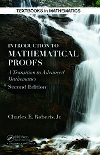- About MAA
- Membership
- MAA Publications
- Periodicals
- Blogs
- MAA Book Series
- MAA Press (an imprint of the AMS)
- MAA Notes
- MAA Reviews
- Mathematical Communication
- Information for Libraries
- Author Resources
- Advertise with MAA
- Meetings
- Competitions
- Programs
- Communities
- MAA Sections
- SIGMAA
- MAA Connect
- Students
- MAA Awards
- Awards Booklets
- Writing Awards
- Teaching Awards
- Service Awards
- Research Awards
- Lecture Awards
- Putnam Competition Individual and Team Winners
- D. E. Shaw Group AMC 8 Awards & Certificates
- Maryam Mirzakhani AMC 10 A Awards & Certificates
- Two Sigma AMC 10 B Awards & Certificates
- Jane Street AMC 12 A Awards & Certificates
- Akamai AMC 12 B Awards & Certificates
- High School Teachers
- News
You are here
Introduction to Mathematical Proofs

Publisher:
CRC Press
Publication Date:
2014
Number of Pages:
416
Format:
Hardcover
Edition:
2
Price:
115.00
ISBN:
9781482246872
Category:
Textbook
[Reviewed by , on ]
Duane Graysay
07/3/2022
See our review of the first edition.
This volume is written as a textbook for mathematics majors and minors in mid-level major courses at the transition from computational courses to courses in abstract mathematics. The book will be a strong choice as primary text or instructor’s reference text. The contents of the text are typical for such a course, including chapters devoted to the fundamentals of logic, set theory, number theory, relations, and functions. The author rigorously develops content in each chapter while writing in a readable, conversational style. Numerous examples and exercises are included to support the reader’s understanding of content and to encourage the reader’s development of skills in reading and writing mathematical proofs.
One attribute that distinguishes Roberts’ book from similar texts is the authors’ choice to incorporate passages that situate some of the major topics, theorems, definitions, and notations from the book’s chapters in historical contexts. The histories are useful for explaining content and conventions that might otherwise seem, to some students, relatively arcane – for example, in the first chapter Roberts explains the historical origin behind the conventional use of Z to denote the set of integers, the origins of the symbol ∈ to denote that an object is an element of a particular set, among others. I found these historical asides both interesting and informative – I certainly learned a few things that I did not previously know! The historical accounts are also useful for reminding students that mathematics is fundamentally the product of human activity by describing some of the personalities involved in developing key ideas in the foundation of each mathematical domain. However, in light of current vigorous conversations about the social and political roles of mathematics, it is important to note that the histories primarily focus on the European origins of the major content areas presented in the text. I state this not to take a stance on the author’s decisions about which histories to include, but rather to note that an instructor who is interested in presenting a broader view of mathematics will need to be prepared to supplement the text with additional sources for historical information.
Dr. Duane Graysay is an Assistant Professor in the Department of Mathematics at Syracuse University. Dr. Graysay teaches methods courses for preservice secondary mathematics teachers and undergraduate mathematics courses for majors and non-majors, including courses in introduction to mathematical proof.
See the publisher's website.
- Log in to post comments




